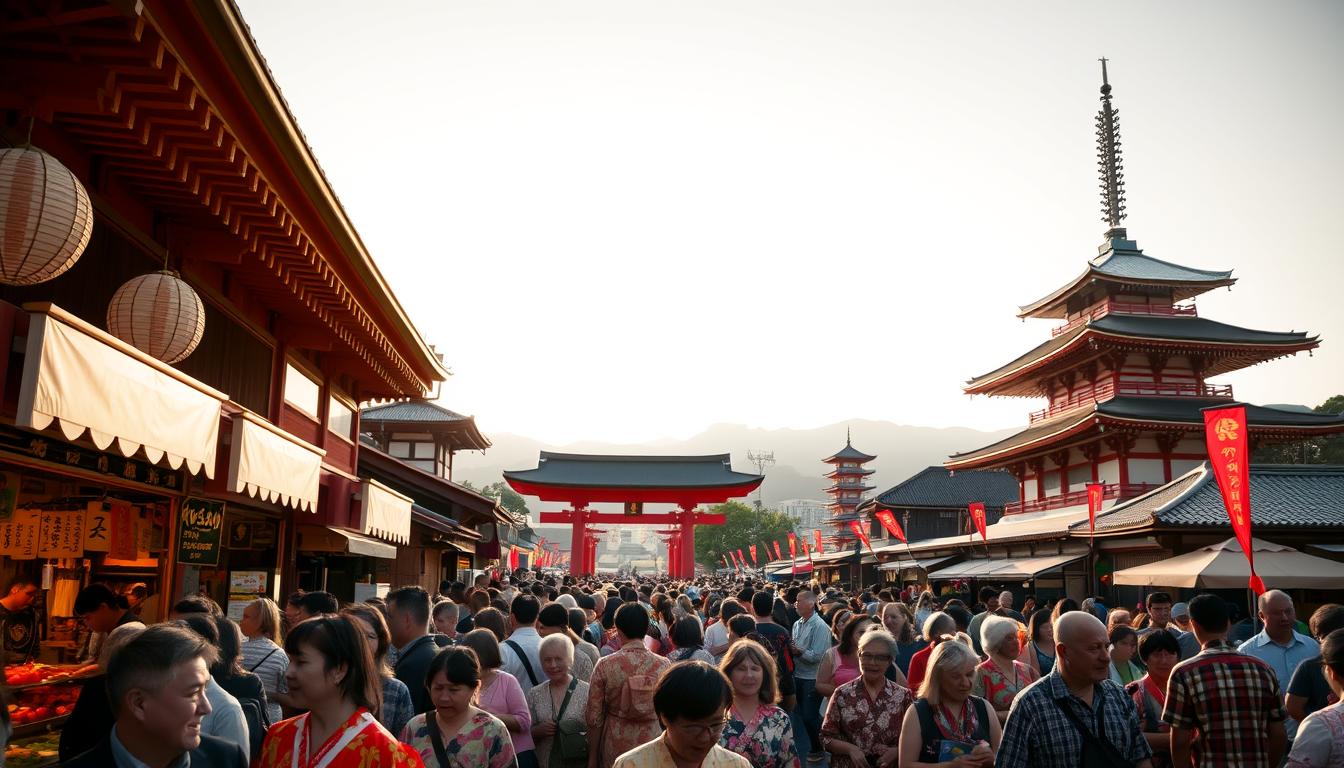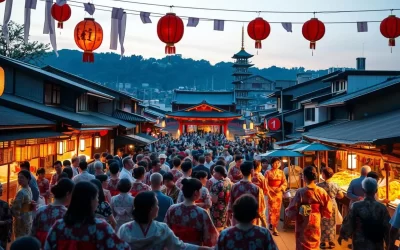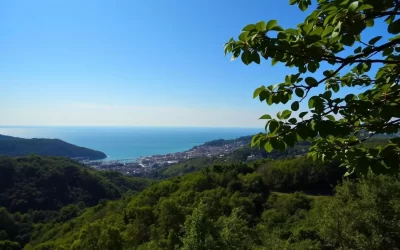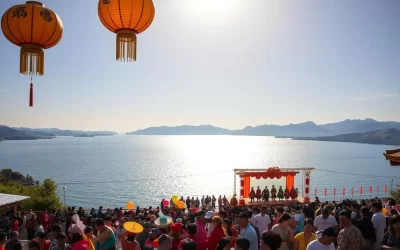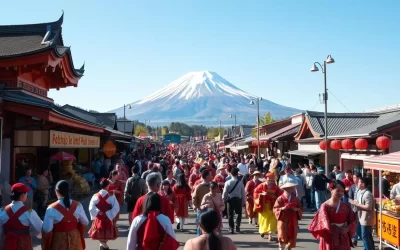Have you ever wondered why festivals are so much more than just celebrations? They are a window into the soul of a place, blending history, art, and community spirit into unforgettable experiences. In this article, you’ll discover why these events are celebrated with such passion and heritage.
From grand parades to intimate gatherings, festivals offer a unique way to connect with a city’s identity. Whether you’re a seasoned traveler or planning your first trip, this guide will take you through major and lesser-known events that showcase the essence of cultural exploration.
Get ready to dive into a world where tradition meets modernity, and every moment tells a story. Let’s explore what makes these celebrations a must-see for anyone seeking an authentic travel experience.
Key Takeaways
- Festivals are a blend of history, art, and community spirit.
- They offer a unique way to connect with a city’s cultural identity.
- This guide covers both major and lesser-known events.
- Festivals provide an authentic travel experience.
- They are celebrated with passion and deep-rooted heritage.
Overview of Kyoto’s Rich Festival Heritage
Festivals in Kyoto are more than just events; they’re a journey through time and tradition. These celebrations are deeply rooted in the city’s history, offering a glimpse into its cultural soul. From ancient rites to modern spectacles, each festival tells a story of heritage and community.
Cultural and Historical Significance
Kyoto’s festivals are tied to Japan’s religious and cultural traditions. Many events originated as rituals to honor deities or mark seasonal changes. For example, the Gion Matsuri dates back over a thousand years, evolving from a purification ceremony to a grand procession.
Local shrines and temples play a central role in hosting these events. Yasaka Shrine, for instance, has been a cornerstone of Kyoto’s festivals since 656. These sacred spaces not only preserve traditions but also bring communities together in celebration.
Festival Traditions and Local Customs
During festivals, ancient customs come alive. From intricate costumes to traditional dances, every detail reflects Kyoto’s rich heritage. The Jidai Matsuri, for example, features a parade of participants dressed in period costumes, showcasing the city’s history in vivid detail.
Local pride is evident in every aspect of these celebrations. Volunteers spend months preparing for events like the Daimonji Gozan Okuribi, where bonfires light up the mountains. These traditions are more than just rituals; they’re a testament to Kyoto’s enduring cultural identity.
“Festivals are not just about celebration; they’re about preserving our heritage and passing it on to future generations.”
Whether you’re watching a parade or joining a ritual, Kyoto’s festivals offer a unique way to connect with its past and present. They’re a reminder of how tradition and community continue to shape this historic city.
Kyoto, Japan: Top Festivals to Check Out When Visiting
What makes Kyoto’s festivals stand out in a country rich with cultural celebrations? These events are more than just spectacles; they’re a gateway to understanding the city’s soul. From ancient rituals to modern-day parades, each festival tells a story of heritage and community.
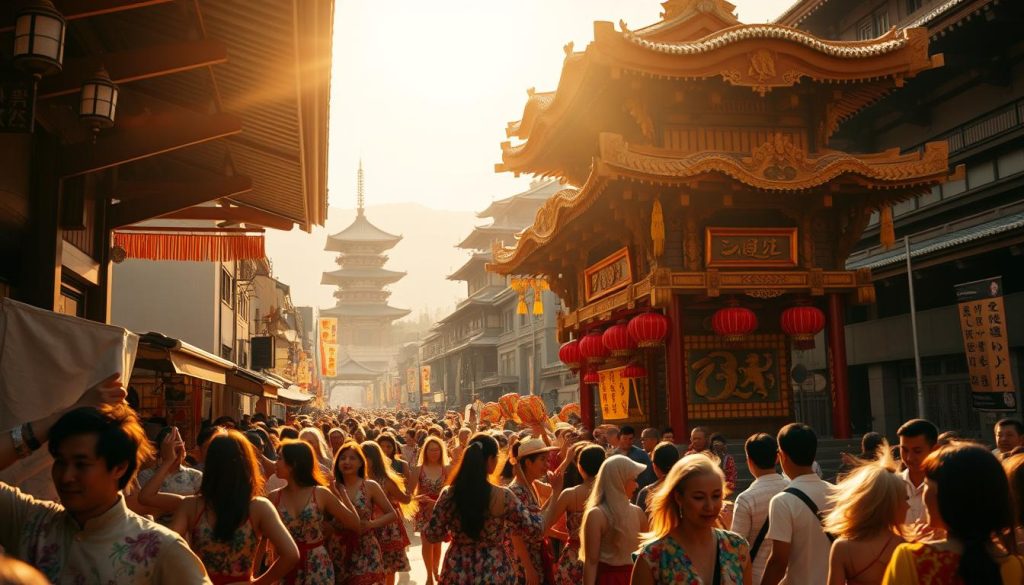
In this section, we’ll explore a curated list of must-see festivals that capture the essence of Kyoto. These events blend centuries-old traditions with contemporary trends, offering a unique travel experience for every visitor. Whether you’re drawn to grand processions or intimate rituals, there’s something for everyone.
Each festival has its own charm, shaping your journey in unexpected ways. For example, the Gion Matsuri, with its history dating back to 869, is a vibrant celebration of Kyoto’s past. Meanwhile, the Daimonji Gozan Okuribi lights up the night sky, creating a mesmerizing experience that stays with you long after the flames fade.
These festivals aren’t just about entertainment; they’re a reflection of Kyoto’s cultural identity. They bring people together, fostering a sense of community and pride. As you explore these events, you’ll gain a deeper appreciation for the city’s heritage and its enduring spirit.
This section serves as a gateway to more detailed explorations later in the article. Get ready to dive into the heart of Kyoto’s festival culture and discover how these celebrations shape the city’s identity. Your journey into this vibrant world starts here.
Exploring Kyoto’s Three Major Festivals
Discover the heart of Kyoto’s culture through its three most iconic festivals. Each event offers a unique blend of history, art, and community spirit, making them unforgettable experiences for visitors. From ancient rituals to grand parades, these festivals bring the city’s heritage to life.
Aoi Matsuri Details
The Aoi Matsuri, celebrated on May 15th, is one of the oldest festivals in the city, dating back over 1,400 years. This event began as a ritual to appease deities at the Kamo Shrines. Today, it features a grand parade that travels from the Imperial Palace to the Kamigamo Shrine.
Participants wear traditional costumes, and the procession includes ox-drawn carts adorned with hollyhock leaves. The festival’s name, “Aoi,” refers to these leaves, symbolizing protection and prosperity. It’s a vivid reminder of Kyoto’s deep-rooted traditions.
Gion Festival Highlights
The Gion Festival, held throughout July, is one of the most famous events in the region. Originating in 869 as a ritual to calm a plague, it has evolved into a month-long celebration. The highlight is the Yamaboko Junko, a parade featuring elaborate floats decorated with intricate designs.
These floats are pulled through the streets of Kyoto, accompanied by traditional music and dance performances. The festival also includes Yoiyama evenings, where the streets come alive with food stalls and vibrant energy. It’s a true spectacle of culture and community.
Jidai Matsuri Overview
The Jidai Matsuri, held on October 22nd, is a living history lesson. This festival commemorates the founding of Kyoto and features a procession of over 2,000 participants dressed in costumes from different historical periods. The parade starts at the Imperial Palace and ends at Heian Shrine.
Each costume represents a specific era, offering a visual journey through Kyoto’s past. The event is a testament to the city’s enduring legacy and its commitment to preserving its history. It’s a must-see for anyone interested in cultural heritage.
These three festivals are more than just events; they’re a window into Kyoto’s soul. Whether you’re watching a parade, admiring the floats, or learning about historical traditions, each moment is a step into the city’s vibrant culture.
Seasonal Festivals: Experiencing Spring and Summer Vibrancy
Spring and summer in Kyoto bring a burst of color and energy, transforming the city into a vibrant celebration of nature and culture. These seasons offer unique festivals that highlight the beauty of the outdoors and the spirit of the community. From delicate blossoms to lively parades, each event captures the essence of the time of year.
Cherry Blossom and Plum Blossom Celebrations
Spring in Kyoto is synonymous with cherry blossoms and plum blossoms. The Hirano Shrine Cherry Blossom Festival showcases over 50 varieties of cherry trees, creating a breathtaking display from early March to May. Visitors can stroll through the shrine grounds, enjoying the delicate pink and white petals.
At the Kitano Tenmangu Shrine, the Plum Blossom Festival celebrates over 900 years of tradition. The shrine’s gardens are filled with fragrant plum trees, offering a serene escape. These festivals are a perfect blend of natural beauty and cultural heritage, making them a must-see in spring.
Summer Traditions and Parade Spectacles
As the weather warms up, Kyoto’s summer festivals take center stage. The streets come alive with energetic parades, traditional music, and vibrant decorations. Popular parks and shrine grounds become hubs of activity, drawing locals and visitors alike.
One of the highlights is the Gion Matsuri, a month-long celebration featuring elaborate floats and lively street performances. The festival’s origins date back to 869, and it remains a cornerstone of Kyoto’s cultural identity. These events are a testament to the city’s ability to blend tradition with modern energy.
| Season | Festival | Highlights |
|---|---|---|
| Spring | Hirano Shrine Cherry Blossom Festival | Over 50 varieties of cherry blossoms |
| Spring | Kitano Tenmangu Plum Blossom Festival | Fragrant plum trees and serene gardens |
| Summer | Gion Matsuri | Elaborate floats and street performances |
Whether you’re drawn to the gentle beauty of spring or the lively energy of summer, Kyoto’s seasonal festivals offer something for everyone. These events are a reminder of how nature and culture come together to create unforgettable experiences.
Unique Festivals Beyond the Major Events
Beyond the well-known celebrations, there are hidden gems that offer a deeper connection to the city’s culture. These unique events provide a different perspective, blending tradition with mystery. They invite you to explore a side of the city that’s often overlooked but equally captivating.
One such event is the Gozan Okuribi, a mesmerizing display that lights up the night sky. Held in mid-August, this festival features large, blazing fires on mountain slopes. The fires form intricate patterns, creating a dramatic and unforgettable experience.
This festival is rooted in ancient traditions, symbolizing the guiding of ancestral spirits. The sight of the fires against the dark night is both awe-inspiring and deeply spiritual. It’s a stark contrast to the daytime parades, offering a unique way to connect with the city’s heritage.
In addition to the fires, the event often includes traditional cormorant fishing. This ancient practice adds another layer of cultural richness to the experience. Together, these elements create a display that’s as educational as it is beautiful.
These lesser-known events are perfect for those seeking a more intimate travel experience. They allow you to step away from the crowds and immerse yourself in the city’s quieter, yet equally vibrant, traditions. Whether you’re watching the fires or learning about ancient practices, these moments stay with you long after the night ends.
- Discover unique events that go beyond the major festivals.
- Experience the mesmerizing nighttime illuminations of Gozan Okuribi.
- Witness the dramatic display of blazing fires on mountain slopes.
- Learn about traditional cormorant fishing and other local customs.
- Embrace the mysterious and unforgettable side of festival culture.
These events are a reminder that there’s always more to explore. They invite you to see the city in a new light, creating memories that last a lifetime. So, when you plan your next travel adventure, don’t forget to include these hidden treasures in your itinerary.
Insights into Lesser-Known Festival Traditions
What if you could take part in a centuries-old ritual during your travels? Beyond the grand parades and vibrant displays, there are hidden gems that offer a deeper connection to the city’s culture. These lesser-known traditions invite you to experience a side of the festival scene that’s both intimate and meaningful.
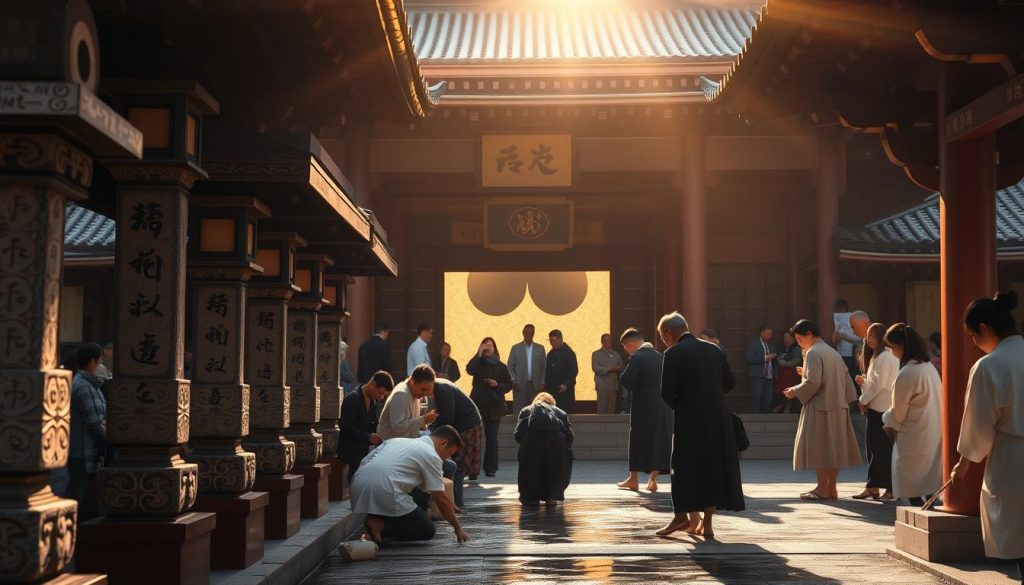
Misogi Matsuri: The Foot-Washing Ritual
One such tradition is the Misogi Matsuri, held at Shimogamo Shrine. This unique ritual involves a foot-washing ceremony that dates back to ancient times. Originally practiced by nobility, it’s now open to everyone, offering a hands-on way to connect with the spirit of the event.
The ceremony is a form of purification, symbolizing the cleansing of the body and mind. Participants wash their feet in the shrine’s sacred waters, a practice that’s both meditative and spiritually enriching. It’s a reminder of how traditions can bridge the gap between past and present.
What makes this festival special is its accessibility. Unlike some events that are purely for observation, the Misogi Matsuri encourages active participation. It’s a chance to immerse yourself in local heritage and gain a deeper understanding of the culture.
This ritual is more than just a ceremony; it’s a way to connect with the spirit of the shrine and the community. Whether you’re a seasoned traveler or a first-time visitor, it’s an experience that leaves a lasting impression.
- Discover the foot-washing ritual at Shimogamo Shrine.
- Experience a centuries-old practice of purification.
- Connect with the spirit of the event through active participation.
- Learn how this tradition bridges the past and present.
- Immerse yourself in a unique aspect of the festival culture.
These lesser-known events are a reminder that there’s always more to explore. They invite you to see the city in a new light, creating memories that last a lifetime. So, when you plan your next travel adventure, don’t forget to include these hidden treasures in your itinerary.
Historical Processions That Bring Kyoto’s Past to Life
Step into a living history book as Kyoto’s streets transform into stages of the past. These events are more than just celebrations; they’re a vivid reenactment of centuries-old traditions. Through detailed costumes and elaborate parades, you’ll witness history come alive in a way that’s both educational and captivating.
Reenactments and Period Costumes
One of the most iconic examples is the Jidai Matsuri, held annually on October 22. This festival features a grand procession of over 2,000 participants dressed in costumes representing different historical periods. From the Meiji Restoration to the Heian era, each group showcases a specific moment in the city’s rich history.
The parade begins at the Imperial Palace and ends at Heian Shrine, covering a route of about two kilometers. The event is a testament to the meticulous preparation and artistic effort behind these displays. Every costume and prop is crafted by local artisans using traditional techniques, ensuring authenticity and cultural accuracy.
What makes this festival unique is its ability to blend art with history. The procession isn’t just a visual spectacle; it’s a dynamic storytelling experience. As you watch the parade, you’ll feel as though you’ve stepped back in time, reliving moments that shaped the city’s identity.
| Event | Highlights | Duration |
|---|---|---|
| Jidai Matsuri | Over 2,000 participants in period costumes | 2 hours |
| Route | Imperial Palace to Heian Shrine | 2 kilometers |
| Preparation | 12,000 costumes and ceremonial items crafted annually | Months of planning |
These events are a reminder of how history can be portrayed as a dynamic, moving spectacle. Whether you’re admiring the intricate costumes or following the procession, each moment offers a deeper connection to the city’s heritage. Don’t miss the chance to witness these living history lessons firsthand.
Modern Twists and Mysterious Festival Elements
Ever wondered how ancient traditions blend with modern creativity in festivals? In Kyoto, these events are evolving, adding fresh layers to centuries-old customs. From fiery parades to rare rituals, the city’s celebrations now offer a mix of mystery and innovation.
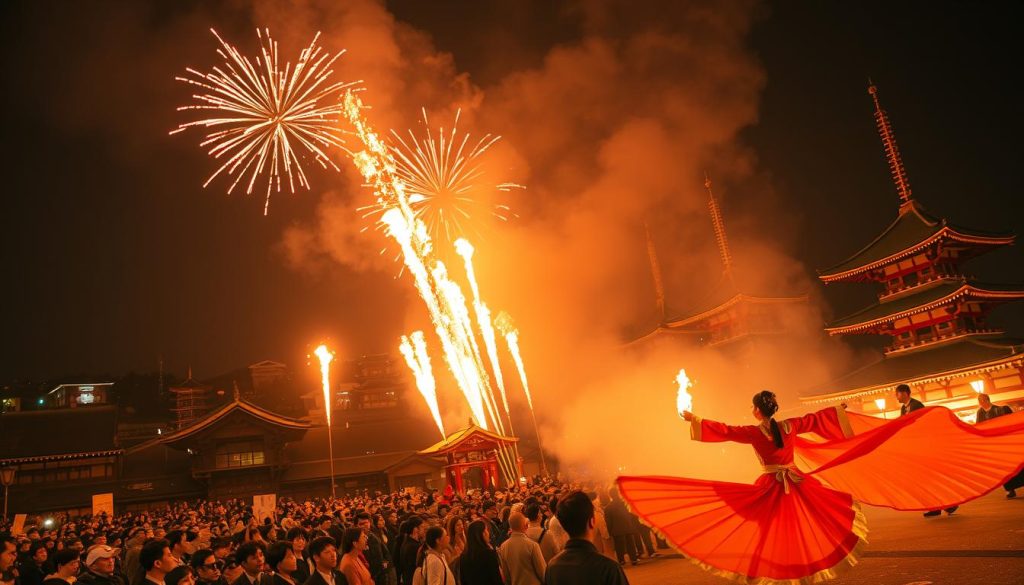
One standout event is the Kurama Fire Festival. Held in October, this festival lights up the night with blazing torches carried through the streets. The atmosphere is electric, as locals and visitors gather to witness this fiery display. It’s a perfect example of how tradition meets spectacle.
Another unique celebration is the Imamiya Yasurai Festival. This event features a rare bull procession, where a sacred bull is paraded through the city. The Uzumasa Ushi Matsuri, another bull-related festival, adds a touch of the unexpected. These events highlight the city’s ability to preserve its heritage while embracing new elements.
These modern twists are designed to attract contemporary visitors. By blending age-old customs with creative innovations, Kyoto’s festivals remain relevant and captivating. Whether you’re drawn to the fiery night parades or the rare bull processions, there’s something for everyone.
- Experience the Kurama Fire Festival’s fiery display that lights up the night.
- Discover the rare bull processions of Imamiya Yasurai and Uzumasa Ushi Matsuri.
- Explore how modern creativity enhances traditional festival customs.
- Witness the unique atmosphere of nighttime celebrations on city streets.
- Be part of events that blend mystery, tradition, and innovation.
These events are a reminder that festivals are not just about the past. They’re a living, evolving tradition that continues to inspire and amaze. So, when you visit, don’t miss the chance to experience these intriguing twists firsthand.
The Spiritual Side of Kyoto’s Festivals
Have you ever felt the deep spiritual energy that flows through Kyoto’s festivals? These events are more than just celebrations; they’re a bridge between the earthly and the divine. Rooted in ancient rituals, they offer a chance to connect with something greater than yourself.
At the heart of these festivals are Shinto shrine rituals and temple celebrations. These practices are not just performances; they’re sacred acts that honor the spirit of the city and its people. Whether it’s a purification rite or a lantern ceremony, each moment is infused with meaning.
Shinto Shrine Rituals and Sacred Ceremonies
Shinto shrines are central to many festivals, serving as spaces where communities come together to honor their heritage. At Fushimi Inari Taisha, for example, rituals like the Misogi Matsuri involve purification ceremonies that cleanse the body and mind. These acts are a reminder of the deep connection between people and the divine.
Another example is the Gion Matsuri, which spans the entire month of July. This festival began as a ritual to appease the gods and has evolved into a grand celebration of community and tradition. The rituals performed during this time are a testament to the enduring spirit of Kyoto.
Temple Celebrations and Heritage Practices
Temples also play a vital role in Kyoto’s festival culture. Events like the Manto-e at Daigoji Temple feature thousands of lanterns, creating a serene and mystical atmosphere. These celebrations are not just about beauty; they’re about preserving heritage and fostering devotion.
One of the most unique temple events is the Omizutori ceremony, which marks the arrival of spring. This ancient ritual includes a fire ceremony that symbolizes renewal and purification. It’s a powerful reminder of how traditions continue to shape the city’s identity.
“Festivals are a way to connect with the divine and honor the past. They remind us of what truly matters.”
These spiritual practices enrich your festival experience, offering a sense of reverence and connection. Whether you’re participating in a purification rite or watching a lantern ceremony, you’ll feel the deep spirit that flows through these events.
- Experience the sacred rituals at Shinto shrines like Fushimi Inari Taisha.
- Witness the lantern-lit beauty of temple celebrations like Manto-e.
- Discover how purification rites and fire ceremonies connect communities with their heritage.
- Feel the spiritual energy that defines Kyoto’s festivals.
Exploring the spiritual side of these events will leave you with a deeper appreciation for Kyoto’s culture. It’s an invitation to connect with the soul of the city and its timeless traditions.
Your Guide to Experiencing Authentic Kyoto Festivals
Ready to dive into the vibrant world of Kyoto’s festivals? These events are more than just celebrations; they’re a chance to connect with the city’s culture and traditions. To make the most of your visit, it’s essential to plan ahead and understand local customs. This guide will help you navigate these experiences like a pro.
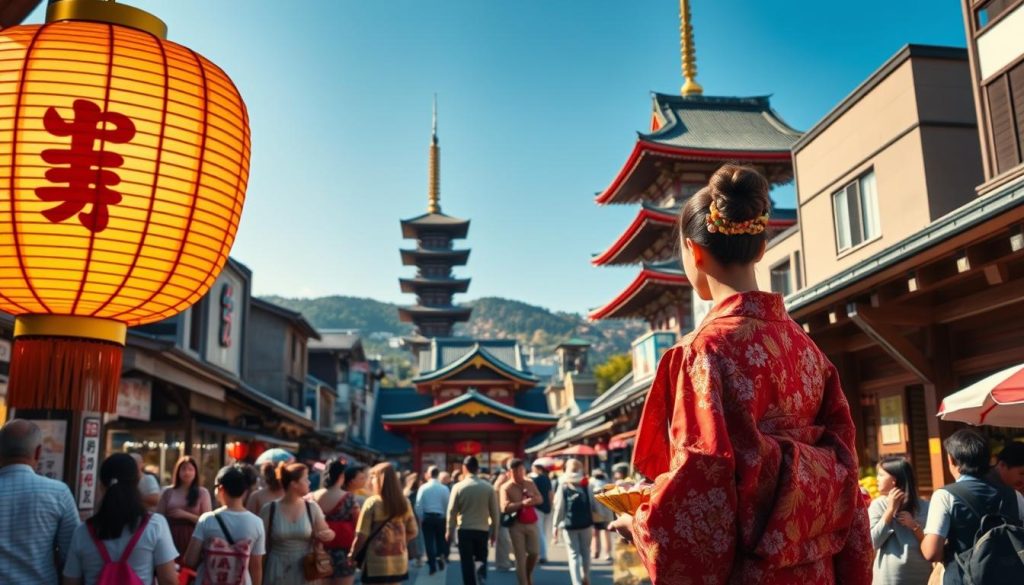
Dress Codes and Festival Etiquette
When attending a festival, dressing appropriately is key. For summer events, many locals wear yukata, a lightweight kimono. It’s a great way to blend in and embrace the atmosphere. Remember to be respectful—avoid loud behavior and follow the crowd’s lead during rituals or parades.
Etiquette is equally important. For example, at the Gion Matsuri, it’s customary to bow slightly when passing by the floats. These small gestures show respect for the culture and enhance your experience.
Planning Your Travel Itinerary
Timing is everything when visiting Japan’s festivals. Major events like the Aoi Matsuri and Jidai Matsuri draw large crowds, so arrive early to secure a good spot. Use public transportation, as streets around the venues are often closed.
To maximize your travel, plan your itinerary around key dates. For instance, the Gion Matsuri spans the entire month of July, with the main parades on the 17th and 24th. Researching these details ensures you don’t miss the highlights.
- Wear a yukata for summer festivals to blend in with locals.
- Be respectful during rituals and parades to honor the culture.
- Arrive early for major events to avoid crowds and secure a good view.
- Use public transportation to navigate festival venues efficiently.
- Plan your itinerary around key dates to catch the best moments.
By following these tips, you’ll not only enjoy the festivals but also gain a deeper appreciation for the way they bring communities together. Prepare in advance, and you’ll create memories that last a lifetime.
The Role of Food and Art in Festival Culture
Ever wondered how food and art bring festivals to life? These elements are more than just add-ons; they’re the heart and soul of the celebration. From savory street treats to mesmerizing performances, they create a sensory experience that lingers long after the event ends.
Local Street Food and Traditional Treats
At any festival, the aroma of sizzling skewers and sweet treats fills the air. Street stalls, known as yatai, line the pathways, offering everything from traditional mochi to grilled yakitori. These culinary delights are more than just snacks; they’re a way to connect with the culture.
One standout is the takoyaki, a ball-shaped snack filled with octopus. It’s a favorite among locals and visitors alike. Another must-try is matcha soft serve, a creamy dessert that captures the essence of the region. Each bite tells a story of heritage and craftsmanship.
These food stalls are more than just vendors; they’re part of the festival’s charm. They bring people together, creating a sense of community and shared joy. Whether you’re savoring a warm taiyaki or sipping on a cold ramune, you’re participating in a centuries-old tradition.
Traditional Art Performances
While food satisfies the palate, art captivates the soul. Performances like taiko drumming and maiko dances are integral to the festival experience. These acts are not just entertainment; they’re a celebration of the region’s cultural heritage.
One highlight is the hanami season, where geiko and maiko showcase their talents under blooming cherry trees. The delicate movements and vibrant costumes are a feast for the eyes. Another must-see is the yakatabune boat performances, where traditional music echoes over the water.
These performances are a reminder of how art can transcend time. They bring history to life, offering a glimpse into the traditions that shape the region. Whether you’re watching a drumming ensemble or a graceful dance, you’re witnessing a piece of living history.
- Explore the vibrant street food scene at festivals.
- Savor traditional treats like takoyaki and matcha soft serve.
- Experience mesmerizing art performances that celebrate cultural heritage.
- Immerse yourself in the sensory delights of festivals.
- Connect with the community through shared culinary and artistic experiences.
When you attend a festival, you’re not just a spectator; you’re part of the celebration. The food and art create a tapestry of experiences that make each moment unforgettable. So, dive in, savor the flavors, and let the performances transport you to another world.
Comparing Festival Experiences Across Japan
How do festival experiences differ across Japan’s most iconic cities? Each city offers a unique blend of history, culture, and tradition, making every celebration distinct. Whether you’re exploring the ancient charm of Kyoto, the vibrant energy of Osaka, or the modern flair of Tokyo, you’ll find something special in every event.
Kyoto’s Timeless Traditions
In Kyoto, festivals are deeply rooted in history. Events like the Gion Matsuri, a UNESCO Intangible Cultural Heritage, showcase centuries-old traditions. The city’s shrines and temples play a central role, creating a spiritual atmosphere that’s hard to replicate. From grand parades to intimate rituals, Kyoto offers a travel experience that feels like stepping back in time.
Osaka’s Energetic Celebrations
Osaka is known for its lively and energetic festivals. The Tenjin Matsuri, one of Japan’s top three festivals, features boat processions and fireworks. The city’s celebrations are more about community and fun, with a focus on food and entertainment. If you’re looking for a vibrant and dynamic festival experience, Osaka won’t disappoint.
Tokyo’s Modern Spectacles
In Tokyo, festivals blend tradition with modernity. Events like the Kanda Matsuri and the Sumida River Fireworks Festival attract millions of visitors. The city’s celebrations are grand in scale, often featuring cutting-edge technology and contemporary art. Tokyo offers a travel experience that’s both traditional and forward-thinking.
- Compare the historical depth of Kyoto’s festivals with the lively energy of Osaka and the modern grandeur of Tokyo.
- Explore how local traditions shape the unique styles of each city’s celebrations.
- Experience the different scales and atmospheres, from intimate rituals to massive parades.
- Plan your travel to include multiple cities for a full spectrum of festival culture.
Each city offers a unique lens into Japan’s rich cultural heritage. By exploring Kyoto, Osaka, and Tokyo, you’ll gain a deeper appreciation for the diversity of festival experiences. Use this guide to plan your journey and immerse yourself in the celebrations that define each city.
Tips for Making the Most of Your Festival Visit
Planning your visit to a festival can transform your experience from ordinary to extraordinary. With the right preparation, you can immerse yourself in the culture and traditions while avoiding common pitfalls. Here’s how to make the most of your time at these vibrant events.
Pre-planning and Engaging with Local Customs
Start by booking accommodations well in advance, especially during peak seasons like spring and autumn. Crowds can swell during cherry blossom and fall foliage periods, so securing your stay early ensures a stress-free trip. Research the festival schedule to prioritize must-see events and hidden gems.
Respect local customs by dressing appropriately and following etiquette. For example, wearing a yukata during summer festivals shows appreciation for the culture. Be mindful of rituals, such as bowing during parades or avoiding loud behavior in sacred spaces. These small gestures enhance your experience and show respect for the community.
Travel Advice and Insider Recommendations
Use public transportation to navigate festival venues efficiently. Streets around popular sites are often closed, making buses and trains the best way to get around. Arrive early to secure a good spot for parades and performances, as crowds can be overwhelming.
For a more intimate experience, explore lesser-known events like the Gozan Okuribi or Misogi Matsuri. These hidden gems offer a deeper connection to the culture and are often less crowded. Don’t forget to try local street food, such as takoyaki or matcha soft serve, to fully embrace the festival atmosphere.
| Tip | Benefit |
|---|---|
| Book accommodations early | Ensures availability during peak seasons |
| Use public transportation | Eases navigation around closed streets |
| Explore lesser-known events | Offers a more intimate experience |
| Try local street food | Enhances cultural immersion |
By following these tips, you’ll not only enjoy the festival but also gain a deeper appreciation for the way they bring communities together. Prepare in advance, and you’ll create memories that last a lifetime.
Conclusion
Immerse yourself in a world where history, art, and community come alive through vibrant celebrations. From grand parades to intimate rituals, these events offer a unique way to connect with a city’s soul. Each festival is a blend of spirituality, tradition, and creativity, making every moment unforgettable.
Plan your visit with care to fully embrace the spirit of these events. Arrive early to secure a good spot, and respect local customs to honor the heritage they represent. Whether you’re watching a procession or joining a ritual, these celebrations provide a deeper understanding of the life and culture they celebrate.
Take the time to explore both well-known and hidden gems. Each event tells a story, offering a glimpse into the past while celebrating the present. Let these festivals inspire you and create memories that last a lifetime. Start planning your journey today and discover the magic of these timeless traditions.
The above is subject to change.
Check back often to TRAVEL.COM for the latest travel tips and deals.
Here are some Tours & Sightseeing suggestions that might pique your interests!
